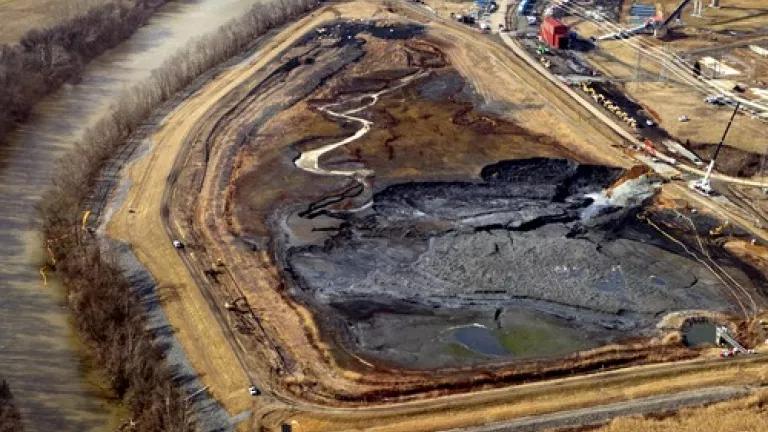
“Those who don’t know history are doomed to repeat it.” – Edmund Burke
This past Sunday, a large storm pipe under an unlined coal ash impoundment at a retired North Carolina power plant broke, releasing up to 82,000 tons of coal ash, and an estimated 27 million gallons of polluted water, into the neighboring river. Unfortunately, this isn’t the first time coal ash has caused massive destruction to the environment and neighboring communities. The infamous 2008 coal ash spill at the Tennessee Valley Authority’s (TVA) Kingston power plant marked as one of the largest environmental disasters in the U.S., flooding downstream communities and affecting millions of residents. Both the TVA spill and the recent spill in North Carolina are the result of decades of lax oversight by state and federal regulators over the management and disposal of coal ash.
Aerial view of unlined coal ash pond at retired North Carolina power plant and the contaminated Dan River (Credit: Waterkeeper Alliance)
What is coal ash and why do we care? When power plants burn coal, they produce waste, which is often referred to as “coal ash,” and lots of it. In 2012, coal-fired power plants generated approximately 110 million tons of coal ash. Coal ash contains a number of toxic heavy metals, including mercury, lead, and arsenic, known to cause cancer, neurological and organ damage. Much of this toxic byproduct is dumped into unprotected and unlined landfills and ponds, or also known as impoundments. Because these impoundments are unregulated at the federal level and at most state levels, the majority of ash ponds lack adequate safeguards. As a result, communities living near such impoundments are vulnerable to large-scale spills like what just happened in North Carolina, and also to the less obvious but equally dangerous risk of coal ash leaching into drinking water sources, especially if the landfill is unlined.
Given the serious health risks that coal ash poses, it is therefore shocking that there are currently no federal standards on how and where coal ash should be disposed. As of today, coal ash is considered an “exempt waste” under an amendment to the federal Resource Conservation and Recovery Act (RCRA). In 2010, the U.S. Environmental Protection Agency (EPA), for the first time, proposed to regulate coal ash. Under the proposed rule, EPA has the option of regulating coal ash as either a non-hazardous waste or a hazardous waste under RCRA. In the wake of this North Carolina disaster, EPA must act to regulate coal ash as a hazardous waste. Under this option, existing and new power plants would not be allowed to build any new coal ash ponds, and any existing landfills would have to be phased out and converted to specially designed landfills.
Regulating coal ash as a hazardous waste is the only way we can ensure adequate protection to our environment and communities from the dangers of coal combustion waste. Although EPA is now under a court order to finalize its coal ash rule by December 19, 2014, the House of Representatives continues to pass amendments to stop the agency from regulating coal ash and letting the states do what they want - thus, maintaining the inadequate status quo.
While having a strong federal coal ash rule can certainly help prevent future contamination from coal ash ponds across the country, another recent EPA proposal may also help to achieve such goal. On June 7, 2013, EPA published a proposed rule governing water pollution from coal-fired power plants in the U.S. As I blogged about here, the aim of the proposed rule is to reduce toxic metals and other pollutants discharged into surface waters by power plants from seven types of byproducts, including coal ash. Under the most stringent option proposed by the water pollution rule, EPA would establish a “zero discharge” requirement for all discharges of pollutants in coal ash. NRDC, along with Earthjustice, Sierra Club, and Environmental Integrity Project, are pushing EPA to select the most stringent option as the final rule because not only would it yield the greatest reduction in toxic discharges from coal ash, but it would also eliminate the use of ash ponds and impoundments, like those now leaking through a broken pipe at the Duke Energy facility in North Carolina.
The federal government has shirked its responsibility for long enough by continuing to let coal-fired power plants off the hook for the ecological damage they cause. Instead, EPA must meet its commitments and quickly issue regulations that protect our environment and citizens from repeated disasters and pollutions caused by coal ash disposal.
